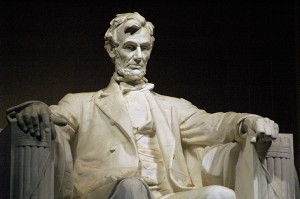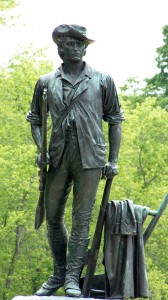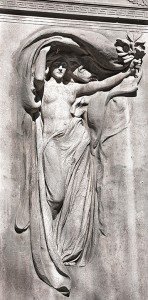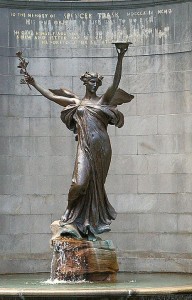
Lincoln Memorial, Jeff Kubina
Donna Hassler is executive director of Chesterwood, the former summer home and studio of Daniel Chester French (1850–1931), a renowned and prolific American sculptor of public monuments best known for the sculpture of Lincoln at the Lincoln Memorial. Located in Stockbridge, Massachusetts, Chesterwood is a historic site of the National Trust for Historic Preservation, a privately funded nonprofit. I recently spoke with Hassler about French’s life and work, Chesterwood, and the value of public art. —Joseph Kellard
Joseph Kellard: Donna, thank you for taking time to speak with me about this great sculptor. I love the works of Daniel Chester French, and I’ve photographed many of them, so it’s a real treat for me to chat about him and his work with such an expert on the subject.
Donna Hassler: You’re welcome.
JK: French was quite prolific, producing more than one hundred monuments, memorials and other works. What would you say are some of the distinctive features and themes of his art?
DH: Daniel Chester French was an American Beaux-Arts sculptor. Trained in Florence and later Paris, he was inspired by the ideal beauty of Greco-Roman art and architecture early in his career. In fact, he didn’t even stay around for the unveiling of the Minute Man sculpture in Concord, Massachusetts, in 1874, because he had accepted an invitation from Ned Powers, the son of the prominent American neoclassical sculptor Hiram Powers, to stay with his family in Florence and study sculpture with another American artist, Thomas Ball. The artist looked to nature in modeling his figurative works but improved upon her in the classical tradition. Allegory and symbolism also played a more important role in his sculpture, especially when he memorialized individuals without portraying them in a realistic manner.
JK: French’s most celebrated sculptures are Abraham Lincoln at the Lincoln Memorial and The Minuteman in Concord, Massachusetts; many of our readers have seen and enjoyed these. Which of his lesser-known works do you think deserve special attention, and why?

Minute Man, Henry Zbyszynsk
DH: Ralph Waldo Emerson, 1879, bronze, Chesterwood, Stockbridge, Massachusetts: I consider the Emerson bust French’s masterpiece in portraiture, accomplished early in his career, not as a commission, but as a private work for himself. When Emerson saw the completed work in plaster, he told the sculptor, “This is the face I shave.” The artist not only portrayed the great American poet and philosopher in an animated, realistic fashion, but also captured the spirit of an individual he had long admired from his beloved town of Concord.
The Melvin Memorial or “Mourning Victory,” 1908, marble, Sleepy Hollow Cemetery, Concord: Perhaps French’s best ideal work, the monumental sculpture depicts a dynamic, female figure emerging from a block of stone, in commemoration of the life of three brothers killed during the Civil War. The impressive architectural setting was designed by Henry Bacon, the architect of the Lincoln Memorial.
The Spencer Trask Memorial or “The Spirit of Life,” 1915, bronze, Congress Park, Saratoga Springs, New York: Spencer Trask (1844–1909) was a prominent New York businessman, a longtime resident of Saratoga Springs, and one of the founders of the Saratoga Springs Reservation Commission. French chose to represent the life of Trask as a draped, winged figure holding a pine branch in one hand (symbolic of the trees on the Trask estate) and a water basin in the other representing the springs that flowed naturally in the town, which Trask had a major role in protecting. French had originally conceived this female form in mourning with lowered head and down-turned arms; but his patron, Katrina Trask, suggested that she wanted to celebrate the exuberance of her husband’s life, and the artist successfully captured that spirit in this work.
Andromeda, 1931, marble, Chesterwood: French’s unknown masterpiece was created late in his life for himself and carved by the Piccirilli Brothers, the same family that had carved the Lincoln Memorial in marble almost a decade earlier. The sculptor felt that “the beauty of woman is beauty at its best and highest,” and his extraordinary ability to model the female form throughout his career will be the subject of a future exhibition that is currently being developed in conjunction with the Boston Athenaeum.

Mourning Victory, Liz West
JK: French sculpted works for a number of public sites, such as the bronze doors for the Boston Public Library. What was his attitude toward public commissions, and how would you characterize his public monuments compared to his private works?
DH: For many artists, portraiture was their “bread and butter.” Daniel Chester French, however, was always working on public commissions, sometimes two at a time in his studios in New York and at Chesterwood. He took his public commissions very seriously, knowing that his sculpture would hold a distinguished place in America’s cultural heritage. His private works, unless they were for himself, were not as intellectually challenging to him as his monumental work; and he would charge a higher fee for a portrait, hoping that someone else would be awarded the commission.
JK: What is the mission of the National Trust for Historic Preservation, and how does Chesterwood fit into that broader mission?
DH: The National Trust for Historic Preservation is a privately funded, nonprofit organization that works to save America’s historic places. From our headquarters in Washington, D.C., and our thirteen field offices, we take direct, on-the-ground action when historic sites are threatened. Our work helps build vibrant, sustainable communities. We facilitate public participation in the preservation of sites, buildings, and objects of national significance or interest. We advocate with governments to save America’s heritage,* and we strive to create a cultural legacy that is as diverse as the nation itself so all of us can take pride in our part of the American story.
Chesterwood is the only artist’s home and studio in the portfolio of National Trust Historic Sites. I am also the administrator of the Historic Artists Home and Studios program of the National Trust. HAHS is a consortium of more than thirty artists’ homes and studios that are open to the public, and preserve and interpret America’s artistic heritage from Maine to California. For more information about the HAHS Sites, your readers should visit the program’s new websites, www.artistshomes.org or www.artistshomesandstudios.org.
JK: When I first visited Chesterwood last year, the tour guide noted that French once said that if he could live for two thousand years, he would sculpt every day. Beyond his huge body of work, can you offer any anecdotes from his life that capture this passion?

Spencer Trask Memorial, N. Lange
DH: French said, “There is nothing like being an artist, be it in paint or music or only mud.” The sculptor was humble to be part of a long, sculptural tradition, but he also recognized as a young man that the “sensuous” quality of his chosen medium enabled him to express himself as an artist in his own time.
JK: French’s daughter, Margaret French Cresson, wrote the only biography of her father, The Life of Daniel Chester French: Journey Into Fame. Why do you suppose no one else has written about his life in depth, and what insights might an updated biography offer?
DH: Actually, Daniel Chester French’s wife, Mary French, wrote the first biography on the artist, titled Memories of a Sculptor’s Wife, in 1928. French was a Renaissance man in the 20th century. His art and life were one and the same; and he lived during a fascinating period in American history, which demands a thorough investigation of both the man and the artist. It is my hope that a definitive biography on Daniel Chester French will be written in the next few years and the author will not only be a great writer, but also a good storyteller.
JK: Again, I greatly appreciate your taking time to speak with me about this terrific artist.
DH: Thank you for your interest in the artist. I hope your readers will plan a trip to Chesterwood in the near future and discover what Daniel Chester French called heaven on earth. French may not be a household name like Norman Rockwell or Andy Warhol, but his work is known by people all over the world who visit the Minute Man in Concord, or the seated figure of Abraham Lincoln at the Lincoln Memorial in Washington, D.C. I guess that is why his monumental sculpture has stood the test of time. It is still relevant today, because it represents our iconic American cultural history. Chesterwood is open to the public until October 13, 2014, Columbus Day, and will reopen in May 2015. Please visit our website at www.chesterwood.org for days and times during the week for visitation. We look forward to seeing you at Chesterwood soon!
* TOS does not endorse government action in this respect. —Editor


![[TEST] The Objective Standard](https://test.theobjectivestandard.com/wp-content/uploads/2017/10/logo.png)












